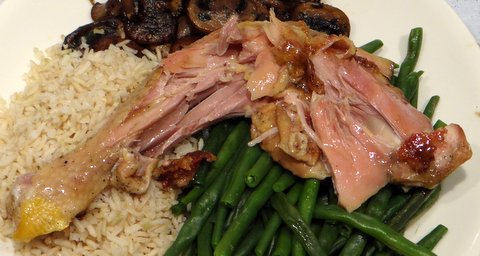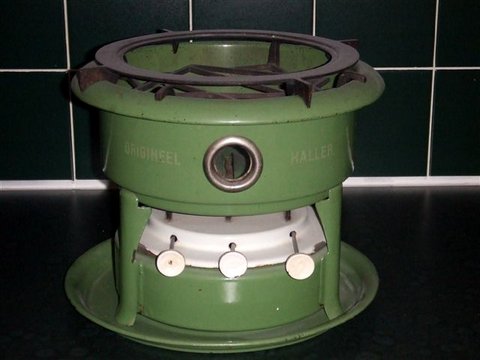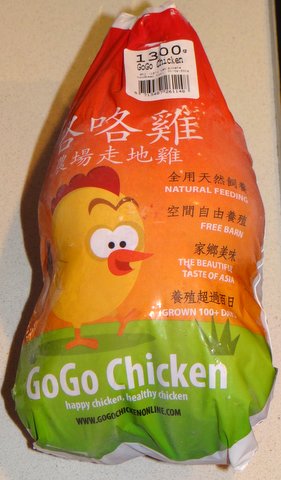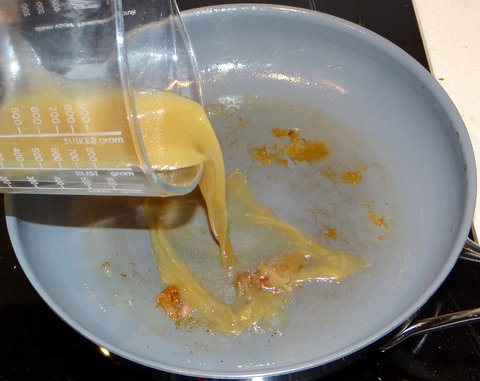
Almost a year ago I wrote about my quest to recreate the braised chicken like my grandmother used to make.
Most people have nostalgic memories of a favorite food made by their mother or grandmother. Just the smell of it will instantly propel you back to your childhood. In many cases the memory has been romanticized by our brains and it may therefore seem impossible to recreate it. For me, this was the braised chicken my grandmother made. Her husband, my grandfather, was the only one who had left the family farm, where his brothers and sister kept livestock including chickens long past retirement age. This included chickens, the original ‘organic’ kind, running around freely in the yard scavenging for food including food scraps from the kitchen. The chickens were held for their eggs, but after a few years the chickens stopped laying eggs and were slaughtered for the meat. Most chicken you buy nowadays has not been allowed to live to retirement age and is not even an adult by the time we eat them — in most cases after only 42 days, they grow so fast that their legs can’t bear their weight anymore; a sign that they are ready to be ‘harvested’. 95% of the chicken sold in the Netherlands is of this type and is called ‘plofkip’ (exploding chicken or ‘thud’ chicken) since the chicken grows so quickly and because of the ‘thud’ when it collapses.
The difference between the meat of a 42-day old chicken that has lived with 19 others on a square meter (that is 2 chickens per square foot) and has been fed optimized feed for fast growing and the meat of 2+ year old chicken that has been running around a yard finding its own food is huge, especially the meat of the legs that have been doing all that running. It is dark rather than white meat and has much more flavor, but is also very, very tough.

So my grandmother had to use one of these (a petroleumstel in Dutch; according to Google translate it’s called a paraffin stove in English) to braise the chicken over very low heat for a day or two in her shed to make it edible. And with the word “edible” I don’t do it justice at all, because I remember it to be phenomenally delicious. The meat was very dark, tender, flaky and flavorful.
To try and recreate this experience, there are two problems: where to find a suitable chicken and how to cook it? As readers of my blog can guess, the second problem is easy to fix for me, as I’m an avid user of a sous-vide water bath and cooking sous-vide is the modern day equivalent of the paraffin stove and very suitable for slow braising. Sourcing the chicken however is not as easy, because even the most expensive chicken available commercially is not more than a few months old. I once paid 50 euros for a single poulet de Bresse to try once and for all whether it was really that special, and was sorely disappointed because it was basically just chicken. It tasted just fine, but nothing special and certainly not worth 50 euros.
My first experiments (post #1, post #2) using stewing hen gave encouraging results. I found out that 62C/144F for 72 hours was optimal for this type of chicken (after trying 60C/140F and 64C/147F as well). Just like my grandmother’s chicken, stewing hens are slaughtered for their meat only after they have been laying eggs for a long time (12-15 months, shorther than my grandmother’s chicken). They have not been running around though, since just like their cousins bred for the meat, they haven’t had much room to do so. The meat of the stewing hen’s legs cooked sous-vide was a bit dry and not as dark and flavorful as I remember my grandmother’s chicken to be.

I had asked around a bit and had almost given up on my quest because everyone was telling me that the type of chickens my grandmother served are just not available anymore. And then I saw frozen chickens at the Asian market labeled “Traditional farmer’s chicken. Natural feeding. Free barn. The beautiful taste of Asia. Grown 100+ days. www.gogochickenonline.com“, written in both English and Chinese. This chicken is produced in the Netherlands for the Asian market in Europe. A regular Dutch frozen chicken of this size (1.3 kg, 3 lbs) is usually sold for EUR 3.39, whereas this one was EUR 11.95 (on sale for EUR 9.95). That explains why this chicken is not aimed at the general Dutch market, because most people here won’t pay that kind of money for chicken. I hesitated a bit because of the tacky packaging, but I’m very glad that I decided to give it a try anyway because this is outstanding chicken! The meat is very dark and is amazingly flavorful compared to regular chicken.

To test the chicken, I simply seasoned the legs with salt and freshly ground black pepper on both sides.

I then vacuum sealed the legs with about a tablespoon of butter. Adding the butter is an improvement on my previous attempts to recreate my grandmother’s chicken that were cooked sous-vide without any added fat in the pouch. Since my grandmother braised the chicken in butter, I thought this would help as well.

Since these chickens are not as old as stewing hens, I decided to cook them sous-vide at 62C/144F for 48 hours rather than 72 hours. This was a good guess, since the chicken came out perfectly tender. 72 hours would probably have turned it to mush.

I collected the juices from the bag in a saucepan…

…and brought the juices to a boil to thicken them somewhat.

I removed the scum using a fine sieve.

I patted the legs dry with paper towels.

I then browned them briefly in clarified butter in a non-stick frying pan over very high heat.

After taking out the chicken, I deglazed the pan with the juices.

I let the juices thicken somewhat, scraping the tasty bits from the pan with a wooden spatula.

I served the chicken with the sauce on brown rice, haricots verts, and sautéed mushrooms.

The chicken was absolutely delicious and perhaps even better than my grandmother’s chicken! The meat was fork tender, flaky, very dark, and had lots of flavor. Compared to this, ordinary chicken is bland and tasteless. My quest has ended and I will buy this chicken again for sure! The difference between allowing the chicken to grow in 140 days rather than 40 days clearly makes a difference.
This is my 299th post on this blog. Stay tuned for a great surprise in the 300th post!


Hallo Stefan,
Een zeer interessante uitdaging die ik ook wel zou willen proberen. Krijgen we misschien eindelijk een lekkere kippenbout. De vraag is nu waar koop ik zo’n kip. Ik kom regelmatig in Amsterdam en Den Haag.
Bij voorbaat dank voor je reactie.
Vriendelijke groeten,
Paul
LikeLike
Beste Paul, deze kippen zijn te koop bij de Aziatische supermarkten van Amazing Oriental, op meerdere plaatsen in Nederland. Zie http://www.amazingoriental.com/filialen
Zou het leuk vinden om te horen wat je ermee gedaan hebt.
Succes,
Stefan
LikeLike
Lovely stuff Stefan. I am reading it in an Amsterdam hotel room after a huge traditional Dutch meal. Sharon and I are looking forward to the next couple of days and the culinary adventure therein.
Best,
Conor
LikeLike
Wow this looks wonderful! I am glad you found your perfect recipe
LikeLike
Funny how the aromas of food can take us back to our youth in the blink of an eye. Our chicken today is “farmed” much like yours is. Most people do not have any idea of what they are missing. We give up so much for convenience. Glad you found a “good” chicken, Stefan, and that you cooked it in such a way as to highlight it’s tenderness and flavor. Sounds delicious!
LikeLike
Great Post. Before moving north, my wife and I raised a variety of chickens called ‘Meat King’… It was my first foray into poultry farming and I was a little afraid that, after years of eating nothing but the industrial varieties available in supermarkets, I might not enjoy them. I worried for nothing because they were fabulous… best I have ever eaten!
LikeLike
Thank you for posting this – sounds great! I know it’s an old post but there is not a lot of info on the web for sous vide with an older chicken. I’ve got backyard chickens and had to butcher a couple of roosters that were about 15 months old – decided to give your method a try, think I’ll go with 72 hours as they are older than the one you found.
LikeLiked by 1 person
I’ve been trying for years to recreate my grandma’s beef stew for years – can’t do it. I do love that chicken packaging – I like the ‘happy chicken’ on the front.
LikeLike
Goedemiddag,
Dank voor uw enthousiaste woorden over ons product!
Binnenkort zullen wij een promostandje hebben bij Amazing Oriental.
Graag nodigen wij u uit om Gogo Chicken dan te komen proeven.
De precieze locaties en tijden zullen wij binnenkort op onze facebook pagina bekend maken.
Vriendelijke gegroet en een fijne zondag toegewenst!
LikeLike
Nice post, Stefan. I may have to check out chickens at the Asian market to see if I can find one of these “farmers chickens” for an old fashioned, southern chicken and dumplings.
LikeLike
I just got some further information from the supplier, and they aim at Asians within Europe. But perhaps the Asian markets in the US have good chicken too.
LikeLike